MXA RACE TEST: 2017 KTM 150SX — RESIST THE URGE TO SHIFT
Click on images to enlarge
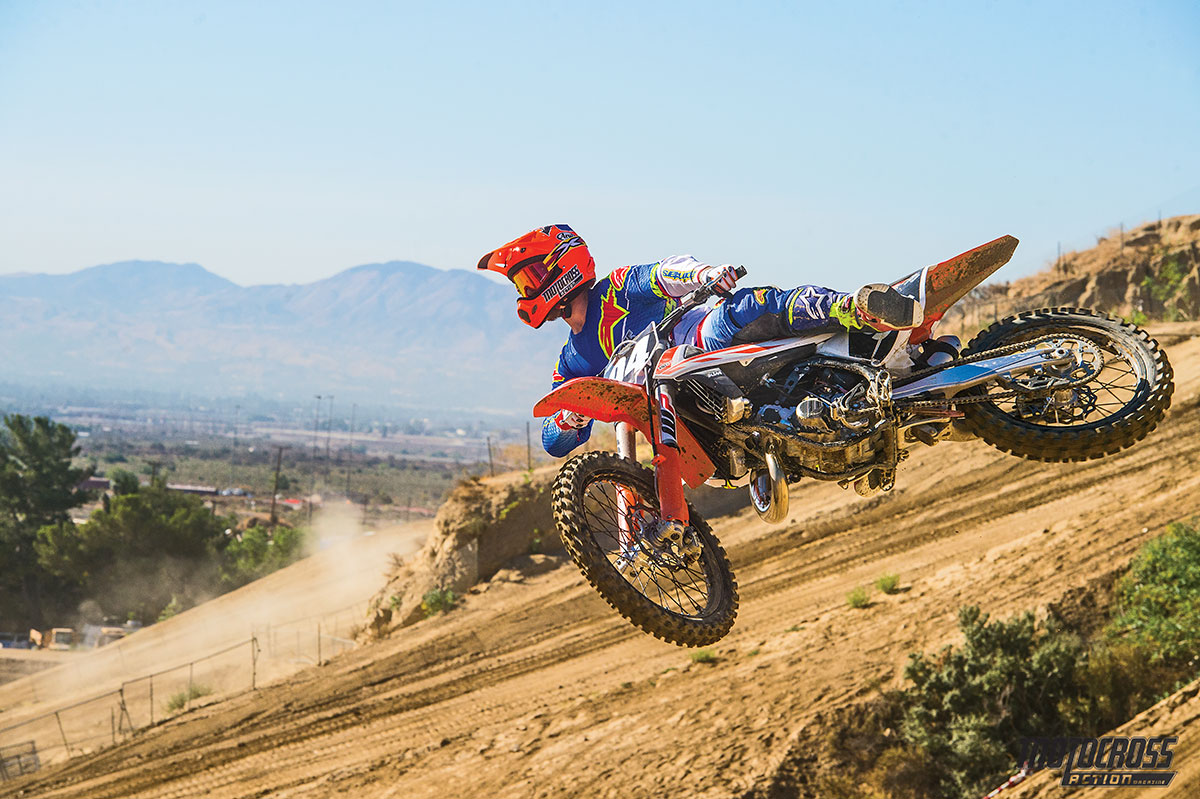
Q: FIRST AND FOREMOST, IS THE 2017 KTM 150SX BETTER THAN THE 2016 KTM 150SX?
A: Yes, without a doubt. And for one reason and one reason alone—the WP AER air forks. These well-damped lightweight, simple-to-use, WP air forks are game-changers for KTM’s reputation. They go a long way towards wiping out the single biggest complaint that riders had about KTM.
Q: WHAT ARE THE DISTINCTIONS BETWEEN THE 125SX AND 150SX?
A: Since the two small-displacement KTM two-strokes look the same and share virtually every component not related to displacement, the only way to tell the 125SX and 150SX apart is by the numerical sticker on the shrouds. If you have a 125SX and want to make it into a 150SX, KTM has a one-part-number kit (SXS-16-150-000) that will give you everything you need to make the transformation. Below are all the internal changes that separate the 125SX and 150SX mechanically.
(1) Displacement. The 150SX is called a 150 for the sake of marketing. It is really 143.99cc. The 125SX is 124.8cc.
(2) Bore and stroke. The 150SX’s bore and stroke is 58mm by 54.5mm, while the 125SX’s is 54mm by 54.5mm. Both bikes having the same stroke means the cylinders are interchangeable. The 125cc can be made into a 150cc and vice versa.
(3) Gearing. Since the 150SX makes more horsepower, it can pull taller gearing, thus the 150SX comes with 13/48 gearing while the 125SX gets 13/50.
(4) Parts. The cylinder, piston, power valve, head stays, power-valve spring on the governor and rings are different in the 125SX and 150SX.
(5) ECU. The ECUs are identical except for the mapping. The ECUs are not interchangeable between the 125SX and 150SX.
(6) Jetting. The 38mm Mikuni TMX carb on the 150SX comes with a smaller main jet.

Almost totally new in 2016, KTM’s 2017 R&D dollars went into suspension refinements. The WP fork used to be their worst feature, and now it is their best.
Q: HOW DOES THE 2017 KTM 150SX RUN ON THE DYNO?
A: Since there are no changes to the engine for 2017, it makes the same exact horsepower as it did last year. No worries, as the 150SX is at the top of the food chain. Its whopping 40.6 horsepower and 18.6 foot-pounds of torque are impressive. To put that into perspective, the 2016 YZ250F (last year’s MXA 250 shootout winner) pumped out 39.35 horsepower at peak (although for 2017 Yamaha increased that to 40.98 ponies). One thing you will notice immediately about the 150SX is that it doesn’t rev as far as the KTM 250SXF four-stroke. The comparable 250cc KTM thumper has its rev limiter set at 14,000 rpm, while the 150SX’s power falls off the edge of the world after 11,600 rpm. In short, the 150SX has a hit-it-and-quit-it powerband.
Q: HOW FAST IS THE 2017 KTM 150SX?
A: The 2017 KTM 150SX engine hauls the mail if you’re up for the challenge. This small-bore engine pumps out more peak horsepower than several of the 2017 250 four-stroke powerplants on showroom floors today; however, don’t get too excited about the peak number. The 150SX powerband is quite a bit shorter and peakier than that of a 250 four-stroke. The difference between two- and four-stroke machines is the way they need to be ridden to reach their full potential. The 250cc four-strokes are extremely easy to ride thanks to their low-end grunt, tractable power and high-rev factor. Thumpers can be cruised, lugged or ridden at a snail’s pace and still have the pickup they need to get moving. On the other hand, the KTM 150SX is asleep at the wheel at half throttle. It doesn’t reach its full potential until the throttle hits the stops and the rider has thrown in a few customary taps of the clutch lever. In short, it takes more work, talent and commitment to ride the 150SX at a fast pace. If you have the ability, the 2017 KTM 150SX has the agility to carve ultra-fast laps on a rough, technical track.
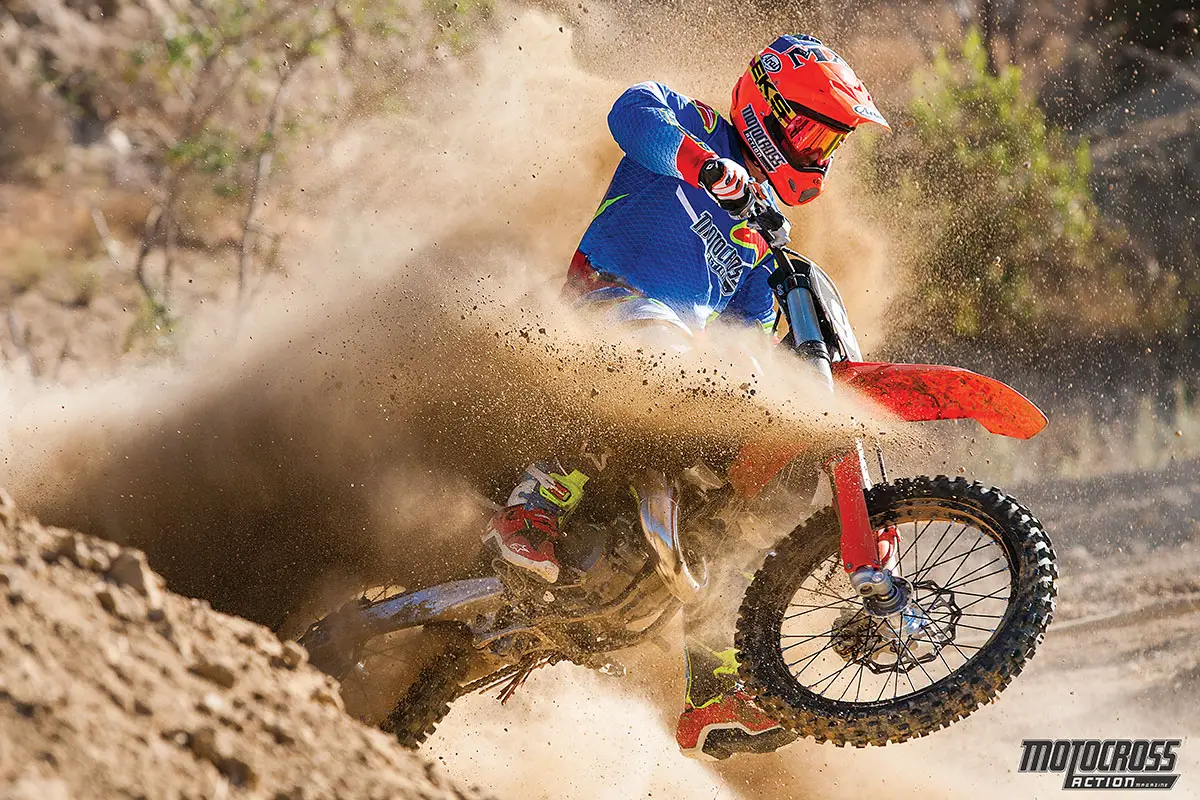
Q: WHAT’S THE BIGGEST DIFFERENCE BETWEEN THE KTM 125SX AND 150SX?
A: Power. To be honest, most MXA test riders prefer to race the 125SX. It has a more organic powerband, revs cleaner and is smoother from gear to gear. The 150SX’s power is harder to manage but makes 3 more horsepower at peak. You can feel that extra oomph, especially on the way to a big jump. Would you rather have an easy-to-ride bike with a broad powerband or a harder-hitting engine that will boot you over big doubles?
Q: WHAT ARE THE EASIEST WAYS TO MAKE THE 2017 KTM 150SX BETTER?
A: Small changes can make a big difference.
(1) Power-valve adjuster. Many MXA test riders wanted a bigger spread. They achieved this by turning the power-valve adjuster all the way out and then in 1/2 turn. This took away some bottom but lengthened over-rev.
(2) Pipe. We had great luck with aftermarket exhaust pipes on both the 125SX and 150SX. They livened up the powerband across the board.
(3) Gearing. Stock gearing on the 150SX is 13/48 (3.692 gear ratio). It’s a good combo for skilled racers who can carry speed. Pro test riders preferred a 14/49 combination by changin both the countershaft and rear sprockets (3.500 gear ratio). Tighter tracks and less-skilled riders did better with a 14/50 blend (3.571 gear ratio).
(4) Gas-cap vent hose. KTM’s vent hose gets twisted in a knot when you try to remove it. We drill a hole in the fork steering-stem cap to slip the vent hose in. Works Connection makes an anodized, pre-drilled version if you don’t own a drill. This mod allows the vent hose to spin with the gas cap.
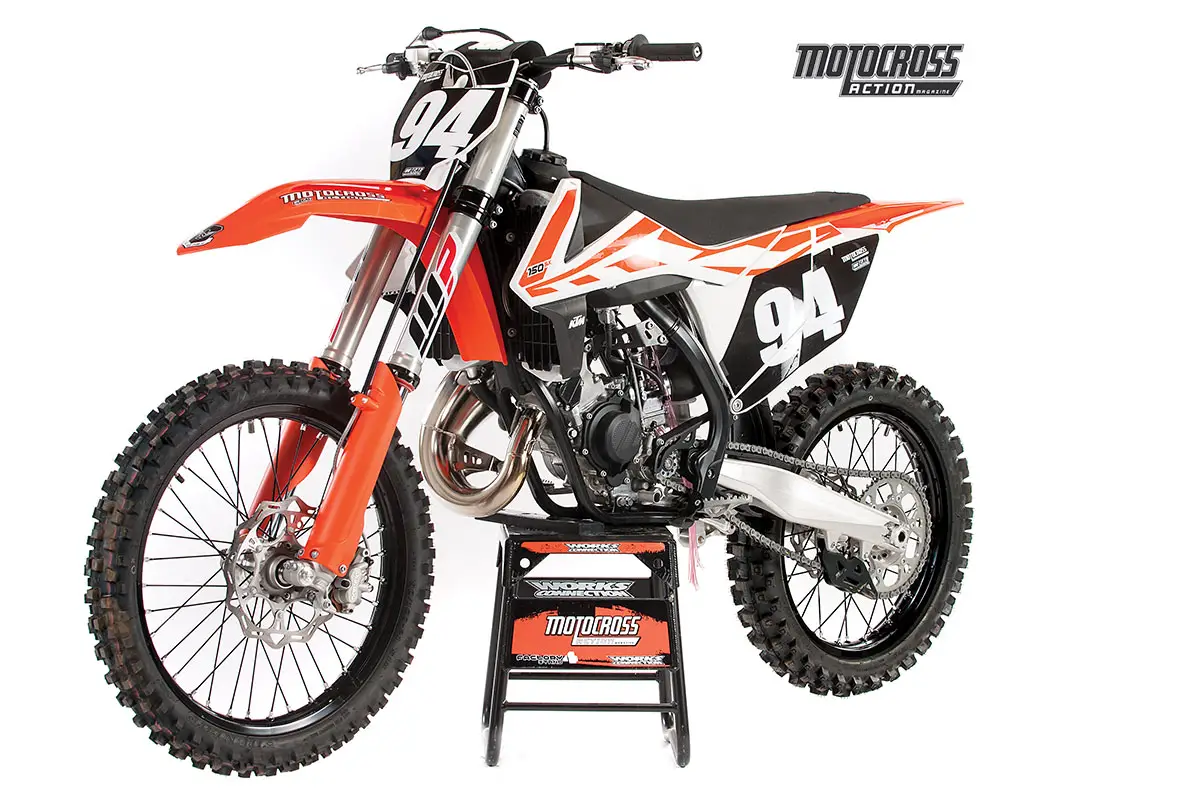
Q: IS THE 2017 KTM 150SX’s SUSPENSION BETTER THAN 2016’s.
A: The 125SX and 150SX got a totally new chassis in 2016. With this solid foundation in place, all of the pressure was placed on suspension supplier WP to up the ante—something it had been unable to do in the past. Last year, the 150SX came with WP’s coil-spring 4CS forks. They were an improvement over the forks from the year before, but that doesn’t mean that we didn’t cringe every time we came up short on a jump or faced consecutive braking bumps. The 4CS forks were much better on the 125SX and 150SX than the same forks on the 250SXF, 350SXF or 450SXF; however, they only exhibited one good trait at a time. They would bottom, but if you turned the clickers in to stop them from bottoming, they became very harsh. You had to pick your poison—supple forks that bottomed or harsh forks that didn’t bottom. Our stop-gap fix was to add oil and use the compression clicker to search for a happy medium.
Enter the 2017 KTM WP AER air forks. With more than a little experience under our belts with KTM’s new WP AER forks, we can tell you that these are great forks. They offer the rider the best of both worlds. These forks can be both plush through the braking bumps and stiff on hard landings. Most of our test riders ran 123 psi. Once we settled on the proper air pressure, we went out on the compression clicker for a better ride over chop. It was painless to find a happy place.
Which is better? KTM’s AER air forks or Yamaha’s Kayaba SSS forks? When comparing apples to apples on the 125/150SX and YZ125, the valving on the Kayaba units is better. The old-school SSS coil-spring forks absorb rough chop like a hovercraft and seem to work for an incredibly wide variety of riders right off the showroom floor. But, the AER forks are in the ballpark (and in a different league from the cranky Showa SFF TAC or PSF-2 air forks). What sets the WP AER fork apart is its vast range of adjustment. Instead of having to change fork springs to compensate for a rider’s weight, all you need is an air pump for the WP units.
(6) Torx bolts. We may have found a way around the Robertson wrench issue on the power valve, but you can’t live successfully with a KTM without a set of Torx wrenches.
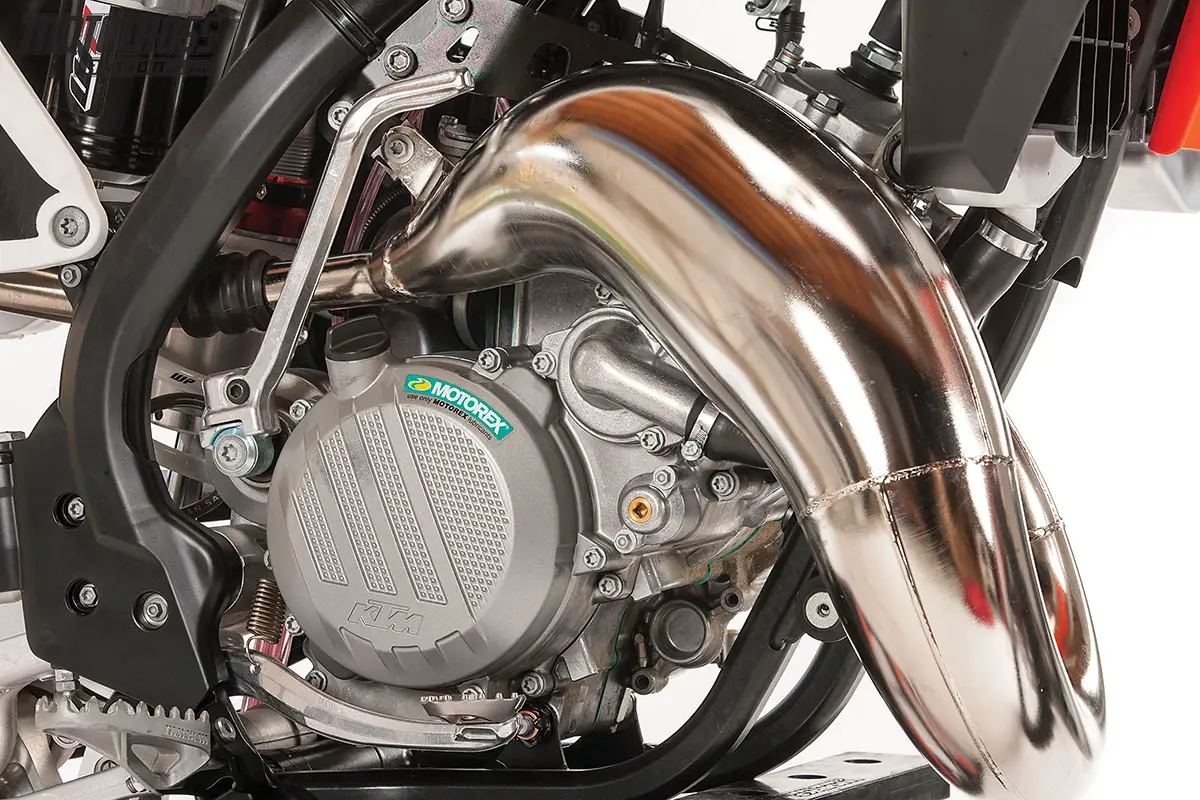
Q: WHAT CHANGES DID KTM MAKE TO THE 2017 KTM 150SX?
A: The changes made to the 150SX were made to KTM’s entire SX line for 2017, save for the ODI lock-on grips (the 125SX and 150SX models didn’t get the grip upgrade).
(1) Forks. For years the soft underbellies of KTMs have been their suspension components. We were happy with the WP shock in 2016, although the WP 4CS forks were an issue. The new WP AER forks are a breath of fresh air. Not only are the forks better, but they shave off 3.6 pounds. That brings the total weight of the 150SX down to 194 pounds. Not bad.
(2) Brake pedal. For the last few years MXA has replaced the KTM brake-pedal tip with a 7602 Racing tip to extend the pedal further. For 2017 KTM lengthened the brake pedal by 10mm.
(3) Brake pads. The rear brake pads now have a glaze over them to increase the control of the rear brake. The consensus was that the previous rear brake was too touchy. If, however, you like more powerful rear brakes, just buy the 2016 brake pads.
(4) Carburetor. Keihin carburetors have been used on KTMs for nearly three decades. For 2017 KTM made the switch to Mikuni. The 150SX comes with a Mikuni TMX 38mm carb. It seems to be a good replacement, although the jetting needs some tender-loving care.
(5) Triple clamps. To support the flex characteristics of the WP AER forks, the upper triple clamp was beefed up.
(6) Bar mount. In 2016 KTM got rubber-mounted bar mounts to reduce vibration. This helped with vibration, but the mounts tended to twist in crashes. For 2017 KTM addressed the issue and replaced the one-piece lower bar mount with a one-piece top mount. If changing the position of the one-piece handlebar clamp made a difference, we haven’t noticed it. They still twist in a crash and bend the top plate.
Q: WHAT DID WE HATE?
A: The hate list:
(1) Wheels. Watch the spokes. Watch the sprocket bolts. And, if big air is your calling card, install stronger spokes or switch to aftermarket wheels.
(2) Shock preload ring. Superman was the Man of Steel. He wouldn’t have been as impressive as the Man of Nylon.
(3) Jetting. Every KTM and Husqvarna that we have tested with the new Mikuni carburetor had to be jetted.
(4) Fork bleed screws. The air-fork bleed screw is a #20 Torx. Don’t use it. On the air side, we use a 10mm T-handle to remove the bleed screw, while on the damping side we replace the Torx-only screw with the Phillips head screw from the 2015 model.
(5) Power valve adjuster. KTM’s power valve is adjusted with a Robertson wrench. We are pretty sure that you don’t own one of these wrenches. We didn’t, either, so we wedged a flat-bladed screwdriver into the slot to make spring preload adjustments.
Q: WHAT DID WE LIKE?
A: The like list:
(1) Brakes. They stop on a dime.
(2) Hydraulic clutch. Bulletproof.
(3) Horsepower. A small-bore smoker that makes 250 four-stroke numbers is impressive.
(4) Airbox. It couldn’t get any simpler.
(5) Sag line. This small detail makes life a lot easier.
(6) Forks. The WP AER forks are good. They are simple in design and superb in function.
(7) Tires. We love that Dunlop MX3S tires come standard.
(8) Weight. It weighs 194 pounds (without fuel in the tank).
Q: WHAT DO WE REALLY THINK?
A: This is the greatest professional practice rider bike ever made. It is more powerful to ride than the 125SX and able to leap tall buildings in a single bound.
MXA’S KTM 150SX SETUP SPECS
This is how we set up our 2017 KTM 150SX for racing. We offer it as a guide to help you find your own sweet spot.
WP AER FORK SETTINGS
First, focus on balancing out the bike for your weight by adjusting the air pressure in the forks. If the forks are diving into the corners, go up a few psi. If they tend to be rigid and pushing out on the entrance of corners, drop the psi a few pounds. For riders from 155 to 170 pounds, we ran 123 psi. Riders 170 to 200 pounds favored 125 psi. Once the pressure was set, all the riders went softer on the compression. The forks have good bottoming resistance, so going softer on the air pressure for a plusher ride was not an issue. For hardcore racing we recommend this fork setup for the 2017 KTM 150SX (stock settings in parentheses):
Air pressure: 123 psi
Compression: 20 clicks out (15 clicks out)
Rebound: 10 clicks out (15 clicks out)
Fork-leg height: Third line
Notes: Don’t worry about the need to check the WP AER forks’ air pressure each and every time you hit the track. Do, however, bleed both of the air screws on the top of the forks, but be gentle with the air side screw.
WP SHOCK SETTINGS
The rear shock was in the ballpark for the majority of our testers. For hardcore racing we recommend this shock setup for the 2017 KTM 150SX (stock specs are in parentheses):
Spring rate: 42 N/m
Race sag: 105mm (110mm)
Hi-compression: 2 turns out
Lo-compression: 10 turns out (15 turns out)
Rebound: 12 turns out (15 turns out)
Notes: Try playing with the sag. At the recommended 110mm of sag, you will get better straight-line stability for faster tracks, but for all-around riding, every MXA test rider went with 105mm.
MIKUNI TMX 38MM JETTING SPECS
Here’s what we ran in our 38mm TMX (stock settings in parentheses):
Main jet: 460 (470)
Pilot: 40 (45)
Needle: 44–74 (43–74)
Clip: 1st clip (3rd clip)
Air screw: 3 turns out (1-1/2 turns out)





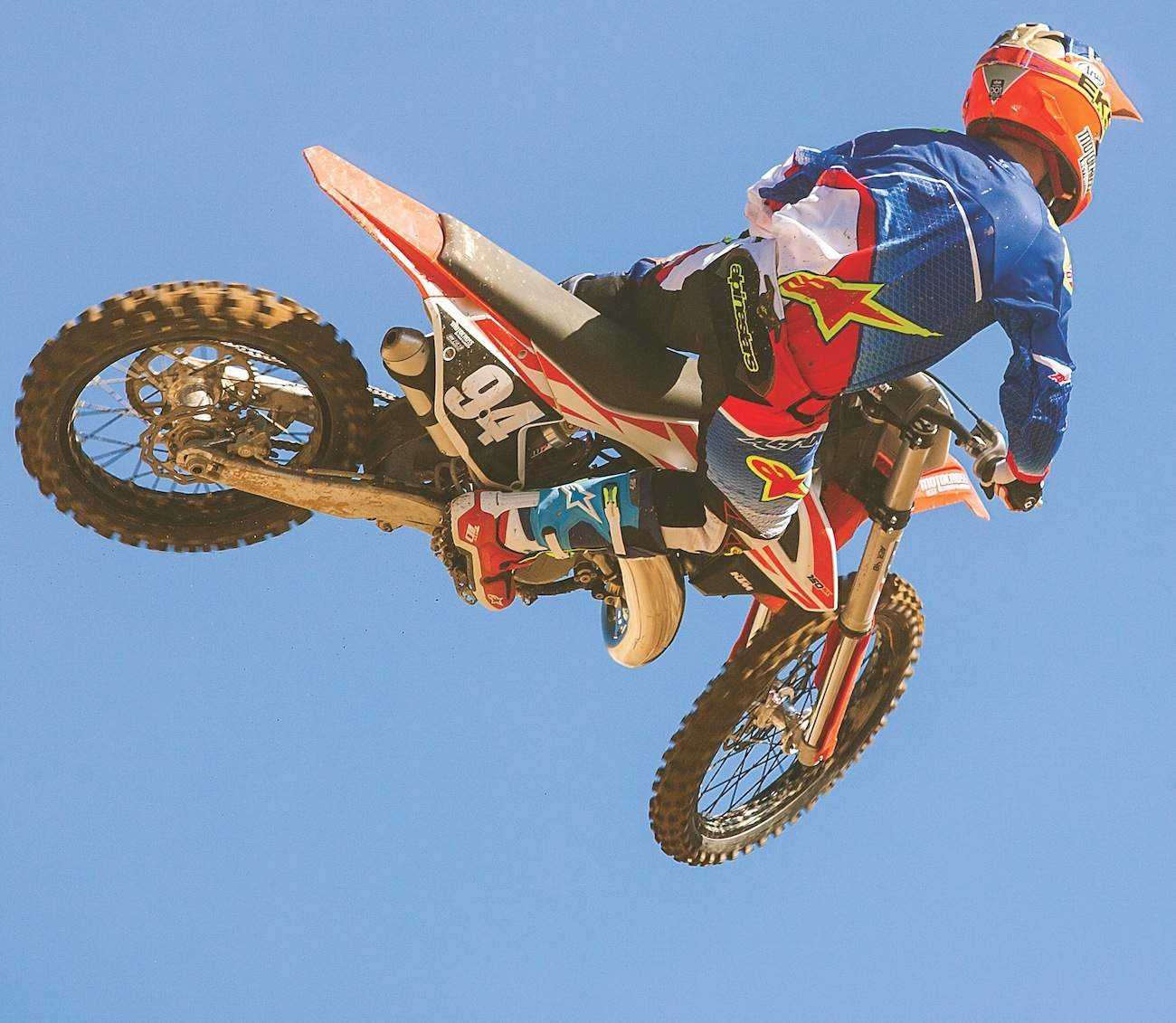
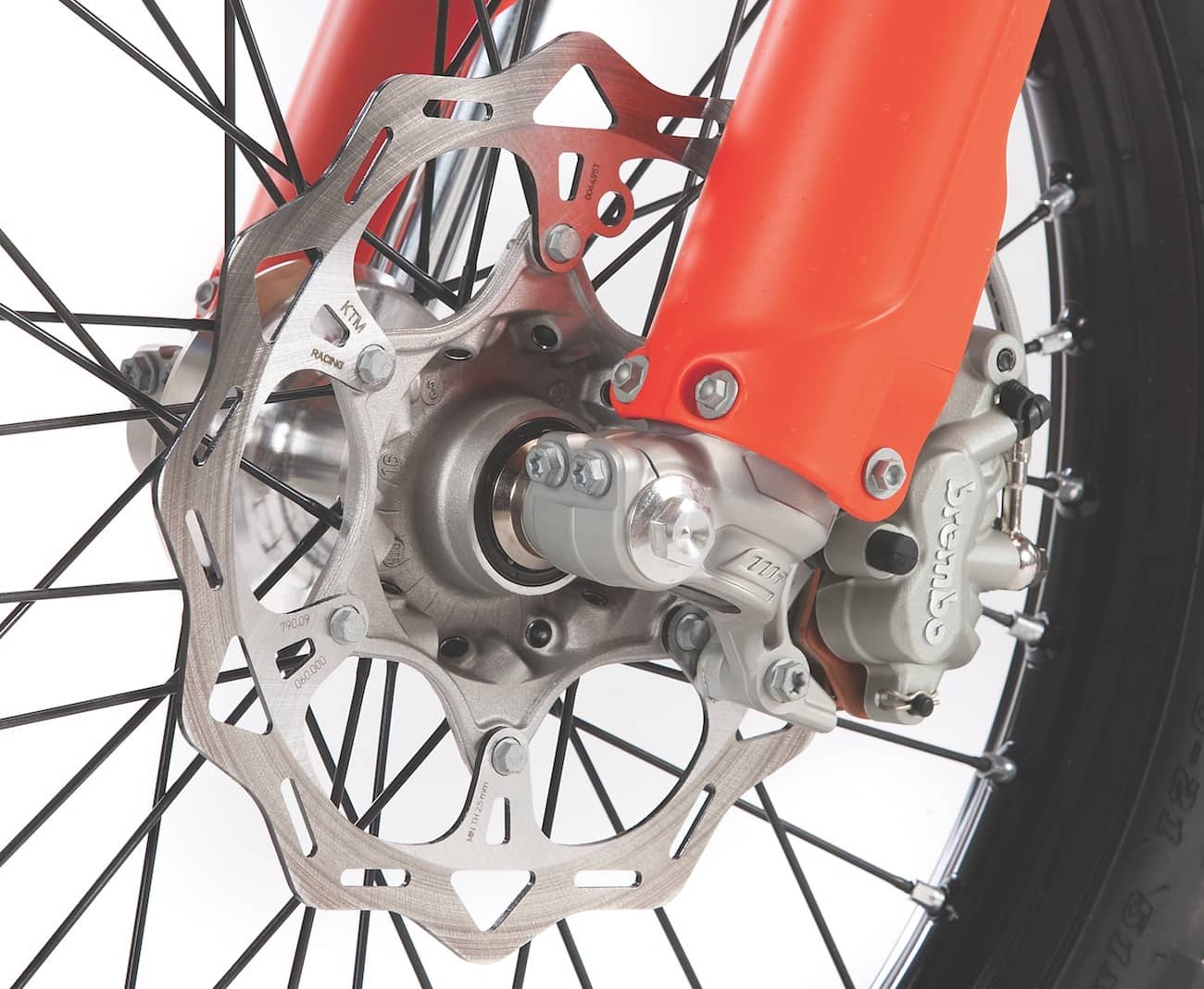
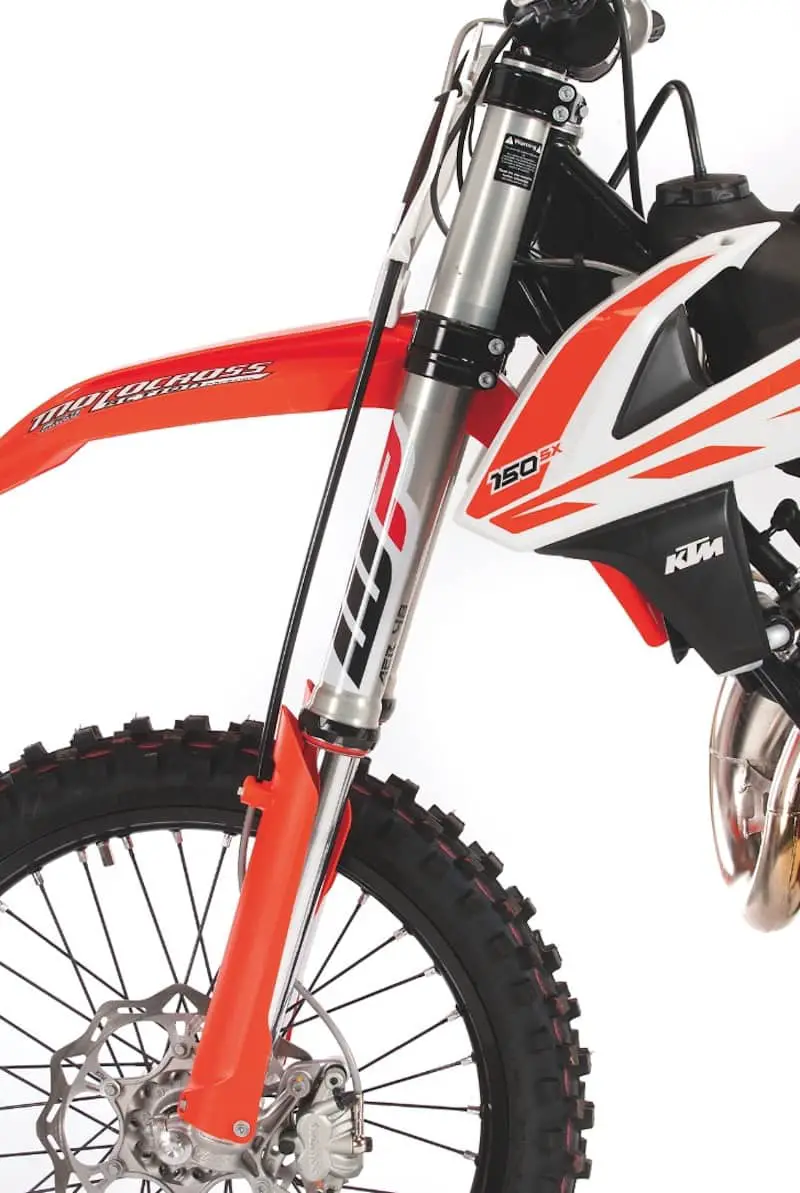





Comments are closed.